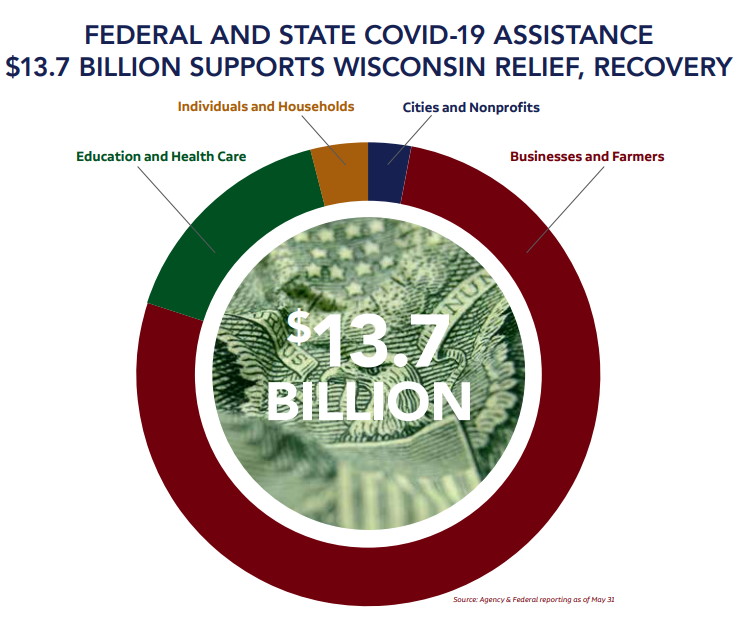State Used Bulk of COVID-19 Relief for Businesses, Farms
New report from WEDC shows how the state spent $13.7 billion in federal and state aid.
A report from the Wisconsin Economic Development Corp. that was released on Monday points to teaching those dealing with unemployment new skills; entrepreneurship; and broadband access as key ways to mitigate the impact COVID-19 has had on the state’s economy.
The report, which was requested by the state Legislature, details the ways in which Wisconsin has spent $13.7 billion in federal and state aid during the first few months of the pandemic to avoid business closures and job losses.
“This is a really complex problem that we’re facing as a state and as a nation,” WEDC Secretary and CEO Missy Hughes said on WPR’s “The Morning Show.” “This is not a tornado touching down in a small town in the middle of Wisconsin. This is something that has impacted every business, every community and every person in the whole state. Solutions moving forward need to take that into consideration.”
Much of the state and federal assistance funding in question went to businesses and farms, followed by education and health care institutions. That aid includes funding from the Paycheck Protection Program for small businesses in the state, disaster loans and the federal relief bill signed into law in March.
She said minority businesses have nevertheless been especially hard-hit by the pandemic. Such businesses typically often don’t have lines of credit, nor do they have relationships built with bankers on whom they can lean for support, said Hughes.
“We’ve seen small businesses that have just literally shut their doors and gone away,” Hughes said regarding businesses owned by racial and ethnic minorities.
Hughes recommended that all small business owners keep up to date with information on Focus Forward, a website from WEDC. She also advised people pay attention to what happens with the PPP over the next few days after its closure on Tuesday.
The U.S. Senate passed an extension of the application period for PPP on Monday. That extension awaits approval by the U.S. House of Representatives.
“We still had $130 billion available,” she said of all the funds still available in the program. “Wisconsin has punched above its weight in accessing those funds. It’s a little challenging to apply for because there’s a lot of hoops, but it’s worth it. Work with your local bank or your credit union and apply for those funds.”
Threaded through the report that touched on all major areas of Wisconsin’s industries was a call for greater broadband services. Such services are needed especially in rural areas where lack of access impedes connections to the greater community, from students trying to reach their teachers to businesses looking for new ways to market products.
“This is something that we can overcome in the state to make sure that everybody has accessible and affordable broadband,” she said.
Like broadband, COVID-19 pointed out weaknesses in other areas like child care, Hughes said. The report highlights a need for quality and affordable early care and education, noting that teachers for young children earn on average $10 an hour without benefits. The report also cited an estimate from the Department of Children and Families that 25 percent of the child care programs in the state could close because of the pandemic.
Options to improve child care in the report include having businesses invest in local child care or subsidizing child care costs.
The report also said that many jobs in the service industry won’t return, and that it will become increasingly important to retrain those workers to get jobs in other fields.
“We need to be thinking about what kind of skills that those individuals need to be able to reenter the workplace,” Hughes said. “Heading into the COVID-19 crisis, we were searching for folks to move to Wisconsin and to help shore up our industries. And so now we have an opportunity to take individuals whose jobs have gone away, get them the right skills and get them into family-sustaining jobs.”
Getting people to start new businesses or take their inventions to market are also a focal point for WEDC, Hughes said.
“That’s where you see real recovery,” she said.
Hughes said while the report looks at just the first few months of the pandemic, she’s hopeful the Legislature will use it to set priorities and focus upcoming discussions.
“We need to all be working together to find solutions for Wisconsin, and I hope that this document provides an opportunity for those conversations to start,” she said.
Hughes said that while the state faces big challenges, the best chance for a full recovery is to continue social distancing, wearing masks and washing hands for at least 20 seconds.
Since the first COVID-19 case was confirmed in Wisconsin on Feb. 5, there have been more than 29,000 positive cases and nearly 800 deaths.
Listen to the WPR report here.
WEDC Secretary Says COVID-19 Report Prioritizes Broadband, Retraining Workers And Innovation was originally published by Wisconsin Public Radio.
More about the Coronavirus Pandemic
- Governors Tony Evers, JB Pritzker, Tim Walz, and Gretchen Whitmer Issue a Joint Statement Concerning Reports that Donald Trump Gave Russian Dictator Putin American COVID-19 Supplies - Gov. Tony Evers - Oct 11th, 2024
- MHD Release: Milwaukee Health Department Launches COVID-19 Wastewater Testing Dashboard - City of Milwaukee Health Department - Jan 23rd, 2024
- Milwaukee County Announces New Policies Related to COVID-19 Pandemic - David Crowley - May 9th, 2023
- DHS Details End of Emergency COVID-19 Response - Wisconsin Department of Health Services - Apr 26th, 2023
- Milwaukee Health Department Announces Upcoming Changes to COVID-19 Services - City of Milwaukee Health Department - Mar 17th, 2023
- Fitzgerald Applauds Passage of COVID-19 Origin Act - U.S. Rep. Scott Fitzgerald - Mar 10th, 2023
- DHS Expands Free COVID-19 Testing Program - Wisconsin Department of Health Services - Feb 10th, 2023
- MKE County: COVID-19 Hospitalizations Rising - Graham Kilmer - Jan 16th, 2023
- Not Enough Getting Bivalent Booster Shots, State Health Officials Warn - Gaby Vinick - Dec 26th, 2022
- Nearly All Wisconsinites Age 6 Months and Older Now Eligible for Updated COVID-19 Vaccine - Wisconsin Department of Health Services - Dec 15th, 2022
Read more about Coronavirus Pandemic here






















